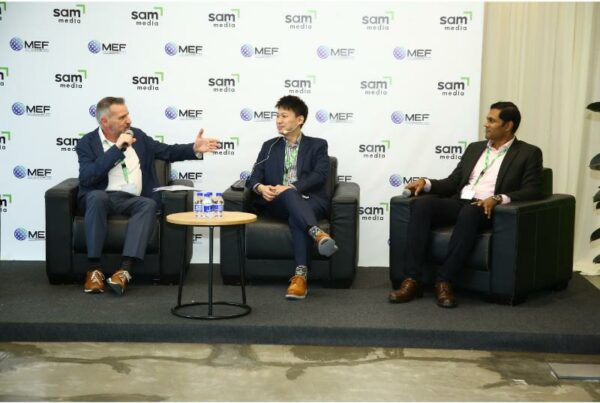Chat bots, selfie-pay, Chinese expansion, loads of M&A and a few high profile failures. 2016 was a big year for the mobile payments space. Here, MEF looks back at the top 20 stories of the last 12 months – starting with 20 to 11…
Mobile payment is normal now – depending as ever on how you define mobile payments. Nearly everyone with a smartphone (and that’s nearly everyone) has bought something from a site or an app on their device.
And every year, they do more of this. Indeed, mobile commerce is now more or less level with desktop commerce. But in-store payment? Scanning or tapping a phone to pay? That’s still far from mainstream.
But it won’t stop the industry from innovating in anticipating of mass adoption. Meanwhile there’s also lots of activity in mPOS, carrier billing, mobile banking and many other forms of mobile money related activity. Here’s MEF’s round up of 2016 (part one)…

20. Mastercard wants to make wearable payments a thing
The emergence of tap to pay makes wearable payments a genuine possibility rather than a nice idea. Plenty have experimented – Barclays has its bPay project for example.
But in 2016, there was major new push by Mastercard. It teamed up with FitPay to reduce the time-to-market, cost and complexity of putting contactless payment inside wearables.
FitPay says its platform requires quick set-up and no investment in software development. The new partnership will see the platform sync with the Mastercard Digital Enablement Service (MDES). This is the service that tokenises payment information to make it safer to move around.
19. Visa goes all-in on APIs: becomes a ‘software company’
The card networks still dominate payments, but the word ‘card’ is growing a bit superflous.
Shoppers don’t use plastic on the internet. And with the arrival of in-store mobile payments, they don’t even need a card in a shop.
So Visa knows it has to be more than a plastic ID card connected to a big ‘trust’ network in the background.
That’s why, in 2016, it opened up its data to third-party software developers for the first time.
Its new Visa Developer platform released 155 APIs. Developer can get access to Visa stuff like account holder identification, person-to-person payment, Visa Checkout, currency conversion and consumer transaction alerts.
Now, any modestly resourced developer team can have access in a few lines of code to network that handles 100 billion transactions a year in 200 countries.
Obviously, Amazon, Facebook. Google et al flourished when they opted to be the platform on which other firms got creative. Now, Visa wants to do the same. Its CEO Charlie Scharf confirmed in a webcast that the company has just gone from being a hardware-based network to a software company.
18. Tanzania lets anyone send money to anyone
After Kenya, Tanzania has a shout for being the world’s most advanced mobile money economy. And in 2016, it went one better than Kenya by supporting a genuinely cross-operator service.
In 2014, Tigo, Airtel and Zantel started a scheme to let anyone pay anyone else. But earlier this year, Vodacom joined in.
Thus, Tanzania became Africa’s first country with full interoperability for P2P money transfers, according to a statement issued by three of the operators.
17. UPI system goes live in India
The idea of sending money to some through a proxy (like a phone number or email address) is familiar to many in the West. It’s what Venmo does – or PayPal or Pingit or Paym. The idea appeals because it lets people send money by phone without knowing the recipients banking details.
In India, there’s a national scheme that supports this convenient idea. In 2016, India’s National Payments Corp (NCPI) officially launched the UPI payments system with the country’s big banks.
UPI lets people transfer funds across different banks using one single identifier, which is the combination of three things: their Aadhar number (a digital identity scheme launched by the government), their bank account number, and their mobile number.
Once a person has registered, the system recognises these three identifiers as one virtual address. It then combines them into a single token sent to the retailer and recognised by the NCPI.
16. Venmo targets merchant payments
PayPal-owned Venmo is America’s favourite P2P money transfer app. Millions of younger people use it to send small sums to friends for rent, take-away food and so on.
But in 2016 company experimented with person-to-merchant payments. It rolled out a pilot program in which users can pay for concert and sports tickets via the app.
Obviously the move was predicted. Across Asia people use apps like WeChat and Line to pay merchants all the time. Meanwhile, Facebook is testing the concept in its app.
Businesses that accept Venmo will be charged 2.9 per cent of each transaction plus a $0.30 fee, according to Fortune. The firm processes around $2.5 billion in P2P payments a quarter.
15. Mobile payment is totally normal in China
While Western users toy with the idea of mobile payment, their Chinese counterparts are configuring their lives around it. Stats from the China Internet Network Information Centre say 64.7 per cent of smartphone users made regular mobile payments in June 2016, up seven points from December last year. That’s 424.5 million people.
It’s happening because of the mature ecosystem built by Tencent/WeChat and Alibaba. And now there’s Apple Pay and Samsung Pay too, with Huawei and Xiaomi also preparing new NFC payments services.
14. Consolidation in carrier billing – DIMOCO buys Onebip, Bango buys BilltoMobile
The charge to mobile sector grows steadily every year, but the number of participants in it keeps falling.
That’s because they keep buying each other. This summer was busy for DCB M&A. Austria’s DIMOCO acquired Italy’s Onebip to boost its presence in the European and LatAm direct carrier billing business.
Days earlier, Bango acquired US-based BilltoMobile from Korea’s Danal. Bango said the deal makes it the market leader in the US, and the only firm that can bill to all the major MNOs there.
The above deals brought more competition to the other big player in the space, Boku, which purchased MoPay in 2014.
13. Consolidation in mPOS – SumUp and Payleven merge
The emergence of Square in the US prompted an explosion of launches in the mPOS space. Startups rushed to offer merchants a cheap and easy-to-set up alternative to expensive card readers.
Inevitably many disappeared. It’s hard to make money from transactions, which retailers already believe are too expensive – even before the mPOS firms gets their cut.
That’s why mPOS firms want to evolve into merchant ‘partners’ that do loans, business analysis, marketing and so on. German competitors SumUp and Payleven merged in 2016 under pressure to deliver this kind of evolution. The two process more than €1 billion annually across 15 countries.
12. Chinese tourists to Europe and Australia can take Alipay with them
China loves to pay by mobile, and 2016 was the year they could start to do so outside of their home country.
Germany’s Wirecard signed an agreement to bring Alipay to Europe. The idea is to tap into a Chinese tourism market worth $165 billion in 2014. Alipay has 450 million active users.
Retailers enter the amount into the ‘Scan Alipay’ app on a mobile device and then scan the QR code on the customer’s smartphone.
A few weeks later Alipay signed a similar agreement with Novatti to bring Alipay to Australian merchants.
11. Alibaba tests Virtual Reality shopping: pay by looking
There’s a continual scramble to make payments friction-free without sacrificing security. And its participants generally leap on any new tech that comes along. Hence Alibaba’s pilot to see if VR can be any help.
The company demonstrated a payment service that will let shoppers wearing a headset pay for things by nodding One presumes the shopper would have already authenticated inside the goggles (perhaps with voice or iris scan) and could then nod at items in a virtual store to check out.
The project builds on a similar scheme to support facial recognition (pay with a selfie…).














